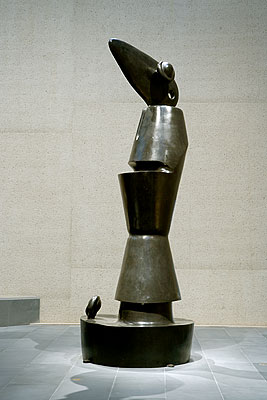National Australia Bank
Sculpture Gallery
new aquisitions, directions and display
 Left-right: Anselm Kiefer Abendland [Twilight of the West] 1989;
Louise BOURGEOIS C.O.Y.O.T.E. [previously known as The blind leading the blind] 1941-48;
Robert Smithson Rocks and mirror square II 1971; Donald Judd Untitled 1974;
Max Ernst Habakuk 1934/70 bronze Purchased with the assistance of the National Australia Bank 2006; Ken Unsworth Suspended stone wallpiece 1976;
Anthony Caro Duccio variations no.7 2000 sandstone and steel On loan from Kenneth Tyler and Marabeth Cohen-Tyler; Constantin BRANCUSI L'oiseau dans l'espace [Birds in space] c.1931-1936; Bronwyn Oliver Garland 2006 copper On loan
Left-right: Anselm Kiefer Abendland [Twilight of the West] 1989;
Louise BOURGEOIS C.O.Y.O.T.E. [previously known as The blind leading the blind] 1941-48;
Robert Smithson Rocks and mirror square II 1971; Donald Judd Untitled 1974;
Max Ernst Habakuk 1934/70 bronze Purchased with the assistance of the National Australia Bank 2006; Ken Unsworth Suspended stone wallpiece 1976;
Anthony Caro Duccio variations no.7 2000 sandstone and steel On loan from Kenneth Tyler and Marabeth Cohen-Tyler; Constantin BRANCUSI L'oiseau dans l'espace [Birds in space] c.1931-1936; Bronwyn Oliver Garland 2006 copper On loan
The new National Australia Bank Sculpture Gallery, the only gallery dedicated entirely to sculpture in an Australian art institution, is now open at the National Gallery of Australia.
The new gallery space shows new acquisitions alongside sculptures that are already part of the Gallery’s significant collection. It will be known as the National Australia Bank Sculpture Gallery for ten years in recognition of a new arts partnership between the National Gallery of Australia (NGA) and National Australia Bank (NAB). This initiative is part of the National Gallery of Australia’s 25th Birthday celebrations.
The arts partnership, announced previously by Mr Rupert Myer AM, Chairman of the National Gallery of Australia Council, includes the commitment of a significant seven-figure investment over the next four years for acquisitions.
Several acquisitions are being displayed for the first time in the new gallery space, including a very significant sculpture by famous European Surrealist Max Ernst (1891-1976), which has been acquired with the assistance of the National Australia Bank.
The bronze sculpture Habakuk, Max Ernst’s largest work of art is a dark, towering, bird-like column, which has a commanding presence, slightly threatening, like a giant bird about to peck you. It is also comic, a person transformed into another form of being. Habakuk is named after a biblical prophet. The Book of Habakuk is one of the last, and shortest, books of the Old Testament, in which Habakuk asks God to curse his enemies. These include the makers of idols, that is, sculptors:
 Max Ernst Habakuk 1934/70 bronze Purchased with the assistance of the National Australia Bank 2006
Max Ernst Habakuk 1934/70 bronze Purchased with the assistance of the National Australia Bank 2006
What profiteth the graven image that the maker thereof hath graven it; the molten image, and a teacher of lies, that the maker of his work trusteth therein, to make dumb idols?
Habukuk will be joined by other recently-acquired works of art such as Maria Feranda Cardoso’s complex interconnected starfish work Woven water: submarine 2003, Cy Twombly’s extraordinarily powerful, attenuated monument Untitled 2005 and Shu Min-Lin’s Glass ceiling 1997-2001 a dynamic interactive holographic installation.
“Over 12 months of planning, extensive restoration, refurbishment and re-lighting of the original space within the Gallery is now completed and our audiences can enjoy seeing Brancusi’s iconic Birds in space 1931-36reinstated within a reflecting pool in this most beautiful gallery in the building”, said Ron Radford, Director or NGA.
“The new NAB Sculpture Gallery places Australian sculpture firmly within the context of international sculptural tradition – our visitors will see Australian pieces side by side with the finest European and American works in our collection”, he said.
John Stewart, Group Chief Executive Officer of the National Australia Bank, said “We are delighted to be able to partner with the National Gallery of Australia to create this exciting new sculpture space. A vibrant and dynamic arts culture is part of Australia’s unique character, and to be able to help the development of Australian artists through the Gallery’s exhibition and acquisition program is something that we are very proud to be part of”.
The new National Australia Bank Sculpture Gallery will be opened for public viewing within the Gallery’s display of the permanent collection from Wednesday 23 May, admission is free.

